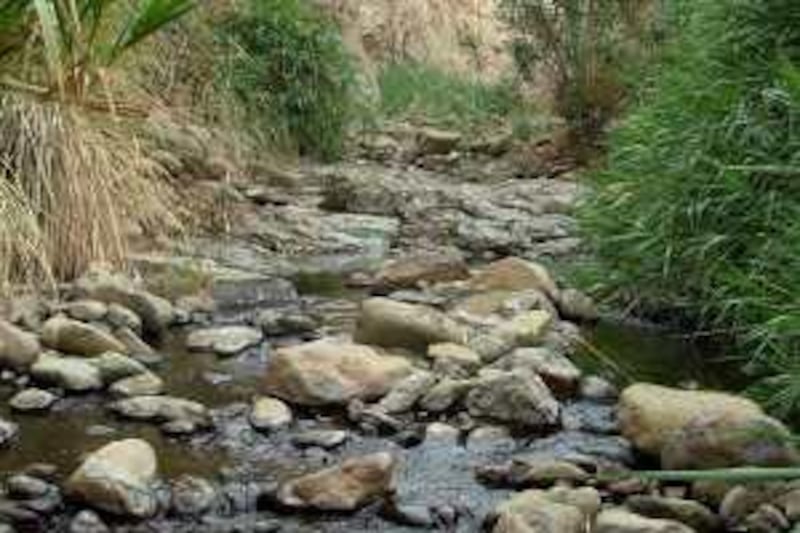ABU DHABI // The discovery of mayflies, parasitic wasps and fruit flies may not mean much to most people. But to specialists working in the field of conservation, finding 85 previously unknown insect species in the UAE is a landmark breakthrough in efforts to better understand the country's unique biodiversity. The insects play a vital role in distinctive ecosystems across the country, such as that at Wadi Wurayah. Tucked into the hills close to Fujairah, the wadi has pools, streams and waterfalls bursting with many species that live off fresh water.
According to Dr Christophe Tourenq, the manager of science and research at the Emirates Wildlife Society (EWS) - World Wide Fund for Nature, the project to identify every living species in the UAE has been ongoing for the past three years. With so much unique life in Wadi Wurayah, simultaneous efforts are taking place to protect the area. Dr Antonius van Harten, an entomologist or insects specialist, has been working for the past three years, collecting specimens all over the country and editing an inventory of arthropod life in the UAE, covering all insects, spiders, scorpions and terrestrial crustaceans.
The first volume was completed in 2007 and a second is in the pipeline, according to Dr Tourenq. "We helped him to find a place, which was Wadi Wurayah," he said. Of the 85 species discovered, seven where found in Wadi Wurayah. Four of the previously unknown species are mayflies, which rely on a good source of fresh water. According to Dr Tourenq, they are also an indication of good water quality. Species of fruit flies and a parasitic wasp are also among the Wadi's unique fauna and the waterfall pool has the only recorded sighting of the Bloody Darter dragonfly.
"The wasp lays its eggs on other insects, mostly caterpillars, and when they develop they feed on the caterpillar, which is necessary for the ecosystem," said Dr Tourenq. With the next volume of Dr van Harten's work in the process of being completed, other discoveries are expected. But smaller life forms are not the only variety to be found at the fertile wadi location. Sightings of endangered species, including the Arabian tahr, a wild goat found only in Oman and the UAE, have been made.
"Since the 1970s the population has declined. You can find them in Jebel Hafeet and Wadi Wurayah, but the population has declined dramatically," Dr Tourenq said. Other animals include the mountain gazelle and lynx. But it is the possibility of a sighting of one of the last Arabian leopards believed to be in the wild that gets some conservationists really excited. The Arabian leopard is among 188 mammals listed as critically endangered by the International Union for Conservation of Nature.
"We believe that one is out there," said Dr Tourenq. "In 2007 we heard a loud roaring sound and in the same year an expedition nearby in Oman found some tracks." Dr Tourenq concedes that it is very difficult to find tracks in the mountainous, rocky area, which does not allow for footprints to be left. However, the EWS is also stepping up tracking efforts by installing additional cameras in remote areas that are activated by movement, capturing images of animals on film. The programme has been going since 2006, but additional funds has enabled the group to purchase more cameras.
"The wadi has permanent fresh water and because of this you have unique wildlife, flora and fauna," said Dr Tourenq. "In an arid country, this is quite unique and there is year-round vegetation." Just like the wadi's fauna, the flora too boasts some unique finds including a particular species of orchid that blooms in March. However, the very things that make the 120-square-kilometre area so special have also been somewhat of a curse, drawing flocks of visitors and weekend campers and, along with them, pollution and rubbish. The EWS has reiterated calls for more to be done to protect the area.
Not everyone is careless, said Dr Tourenq, but it only takes a few to pose a serious risk to the fragile ecosystem. There is a "heavy pressure" on the site, he said, with graffiti on some rock faces posing a particular challenge. "The problem is that people do not only leave footprints, but also trash," he said. "The graffiti is also very difficult to remove and requires very toxic products." One of the immediate needs is proper disposal facilities, Dr Tourenq said, which is something that is being addressed.
Despite the problems, Wadi Wurayah remains a singular locale and its status looks set to be boosted even further. Dr Tourenq is expecting an "imminent" announcement naming the wadi a protected area, which would make it the first protected mountain area in the country. "Mountain habitats are under particular pressure because you need stones and cement for major coastal developments and they find these in the mountains," he said. "It is so important to protect Wadi Wurayah because of its biodiversity and fresh water environment."
Once protected-status comes through, EWS and the municipality are planning to develop a visitors centre, which will also provide jobs for local residents who would work as guides at the site. "The wadi has been used and known by the local people for ages and there is even evidence of pre-Islamic settlements in the area, including gravestones," said Dr Tourenq. The ambitious plans for Wadi Wurayah are testament to its importance as a key source of unique flora and fauna and forms part of the only WWF projects geared towards protecting fresh water resources on the Arabian Peninsula.
"This is very important because people have to recognise that out of this harsh environment, very special species have adapted," he said. "Wadi Wurayah is a unique place where you have water and life." zconstantine@thenational.ae






